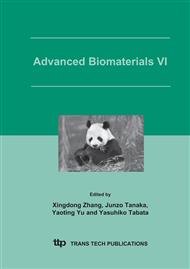p.377
p.381
p.385
p.389
p.393
p.397
p.401
p.405
p.409
In Vitro and In Vivo Evaluation of Amino Acid-Functionalized Cellulose Beads for Whole Blood Hemoperfusion
Abstract:
Phenylalanine linked to cellulose beads was designed as an adsorbent in whole blood hemoperfusion for the therapy of rheumatoid arthritis. In whole blood perfusion tests, the adsorbent adsorbed rheumatoid factors directly from whole blood. In vitro test showed that the adsorbent had good biocompability properties. No acute systemic toxicity and dermal irritancy with extremely low skin sensitizing activity were observed. In vivo animal test with satisfactory results was perfumed with rabbits. Experimental results show that the adsorbent holds promise as a highly effective and safe hemoadsorbent in clinical therapy for rheumatoid arthritis patients by hemoperfusion.
Info:
Periodical:
Pages:
393-396
Citation:
Online since:
June 2005
Authors:
Keywords:
Price:
Сopyright:
© 2005 Trans Tech Publications Ltd. All Rights Reserved
Share:
Citation:


